1993 VOLKSWAGEN GOLF light
[x] Cancel search: lightPage 5 of 156
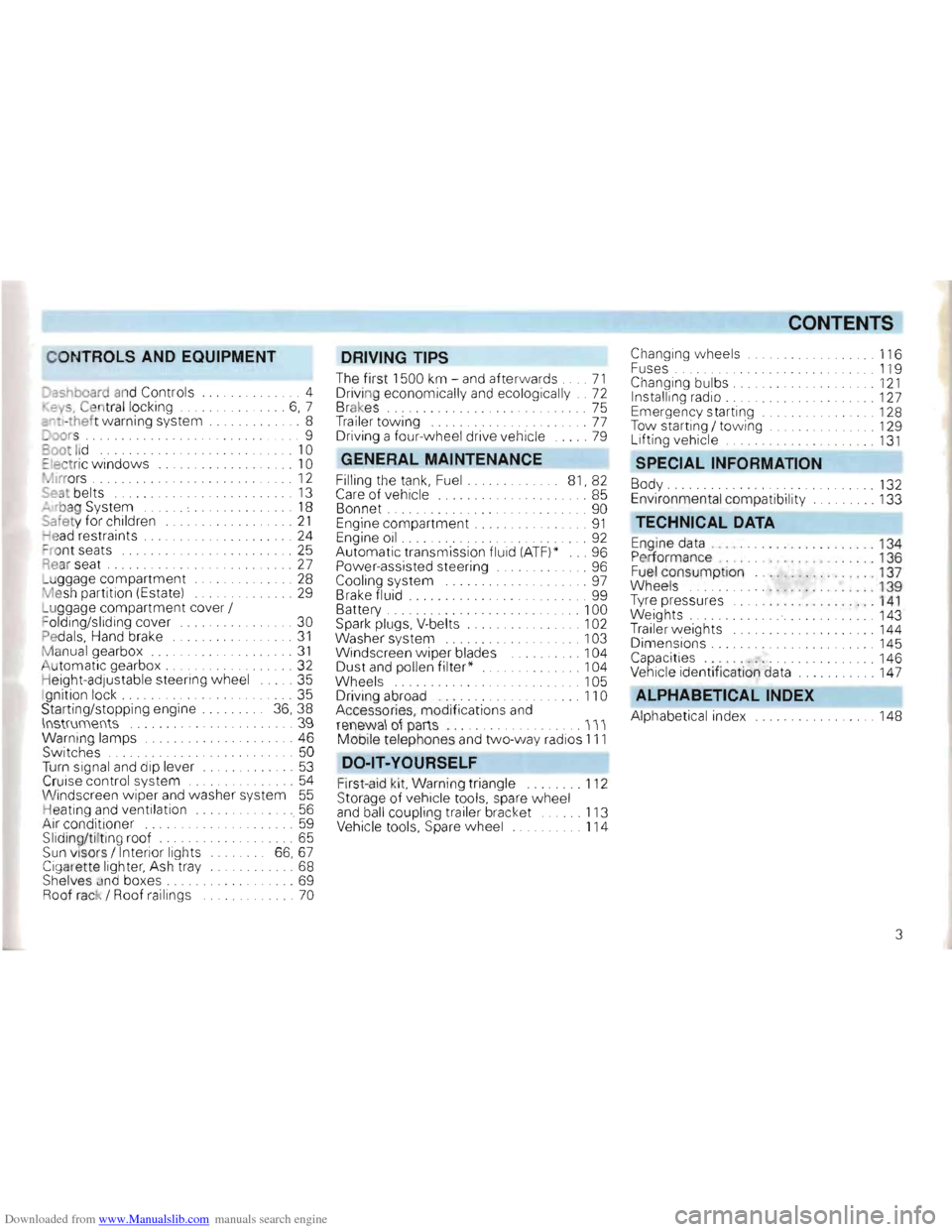
Downloaded from www.Manualslib.com manuals search engine CONTROLS AND EQUIPMENT
Dashboard and Controls ..... 4
. ey s, Cen tral locking . . .... 6, 7
::"tl-thef t warning system .... 8
Joors .......................... .... 9
oot lid .... ........... . . . . . 10
::Iectric windows .. . .. 10
• ~Irrors . . ..... . ... 12
Seal belts 13
"" rbag System . . . . . 18
Safe ty for children .. ... 21
ead restraints . . . . . .. 24
= ro nt seats . . . . . . . . . . . .. 25
Rear seat . . . 27
L u ggage compartment ... . ... . ...... 28
M esh partition (Estate) ...... 29
L u ggage compartment cover /
F olding/sliding cover
... 30
Pedals, Hand brake .. 31
Manual gearbox .... ... .... 31
Automati c gearbox . . . .. .......... 32
H eig ht-adjustable steering wheel ..... 35
I gnition lock. . . . . .. 35
Starting/stopp ing engine 36, 38
\lIstrumellts .. .... 39
Warning lamps ....... 46
Switches . . . . . . . . . . . . . . 50
Turn signal and dip lever ............. 53
Cruise control system ........... 54
Wi ndscreen wipe r and washer system 55
Heating an d ventilation .. . ...... 56
Air cond itioner ......' 59
Sliding/ti ltin g roof. . . . . . . . . . . . ... 65
Sun visors / Interior lights 66,67
Cigarette lighter, Ash tray ..... 68
Shelves and boxes . . . . . . . . . . . ... 69
Roof rack / Roof ra ilings ... 70
DRIVING TIPS
The firs t 1500 km -and after wards .... 71
Driving economically and ecologically .. 72
Brakes. . . . . . . . . . . . . . . . 75
Tra iler tow ing . .. ..... . .... ... ...... 77
Driving a four- wheel drive vehicle .. 79
GENERAL MAINTENANCE
Filling the tan k, Fuel. 81, 82
Care of vehicle ........ .. . . 85
Bonnet . . ... 90
Engine compartment .. ...... .... .... 91
Engine oil ..... .......... ........... 92
Automatic transmission fluid (ATF)* ... 96
Power-assisted steering .. 96
Cooling system . . . . . . . . . . .. . 97
B rake fluid ...... 99
Battery . . . . .. 100
Spark plugs. V-belts . . . . . . . . . 102
Washer system
... . .. 103
Windscreen w iper blades . . . 104
Dust a
nd pollen filter * . 104
Wheel s . 105
D riving abroad ..... ............... 110
Accessories, modifications and
renewa l ot parts .............. III
Mobile telephones and tw o-way rad ios 111
DO -lT-YOURSELF
First -aid kit, Warn ing triangle ........ 112
Storage of vehicle tools, spare wheel
a n d ball coupling trailer bracket ...... 113
Vehicle tools, Spare wheel 114
CONTENTS
Changing w heels . 116
F uses . ........ .. .. . . . ... . .... 119
Changing bulbs. . .... .. . 121
Installing radio . . . . .. 127
E mergency starting .. .. 128
Tow starting / to wing . . .. 129
L ift ing vehicle ......... 131
SPECIAL INFORMATION
Body ..... .... . .......... 132
Environmental compatibility ... 133
TECHNICAL DATA
Engine data . .. , .... .... . 134
P er forman ce .. ... ... ... . .. 136
Fuel consump tion .. 137
Wh eels
. . 139
T yre pressures
.. .. ... .. . . .. ... 1 4 1
Weights ... 143
Trailer weights .. 144
Dimensions. ...... .. ... 145
Capacities " ..... 146
Vehicle identification data ... 147
ALPHABETICAL INDEX
Alph abetical index ... 148
3
Page 7 of 156
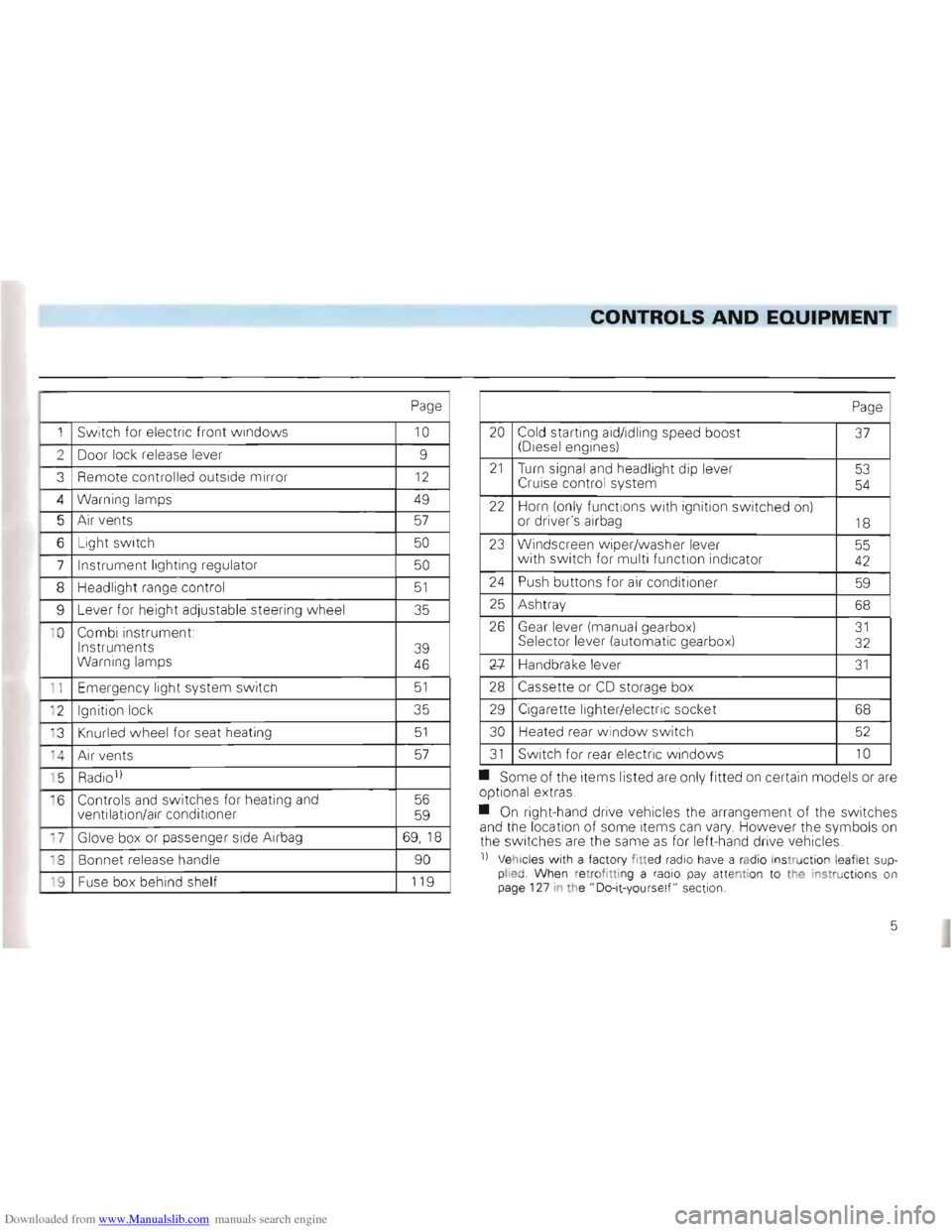
Downloaded from www.Manualslib.com manuals search engine __CONTROLS AND EQUIPMENT
Page
1 Switch for electric front windows 10
2 Door lock release lever 9
3
Remote controlled outside mirror 12
4 Warning lamps 49
5 Air vents 57
6 Light switch 50
7 Instrument lighting regulator 50
8 Headlig ht range control 51
9 Lever for heig ht adjustable steeri ng w heel 35
1 0
Combi instrument:
Instruments
Warning lamps
39
46
1 1 Emer gency light system switch 51
' 2 Ignition lock 35
' 3
Knurled wheel for seat heating 51
'4 A ir ve nts 57
' 5 Radio 1)
·6 Controls and switches for heating and
ventilation/air conditioner 56
59
17 Glove box or passenger side Airbag 69,1 8
18 Bonnet release handle 90
'9 Fuse box behind shelf 119
Page
20 Cold starting aid/idling speed boost (Diesel engines) 37
21 Turn signal and headlight dip lever
Cruise control system 53
54
22 Horn (on ly functions with ign ition switched on)
or driver's airbag 18
23 Windscreen w iper/washer lever
w ith switch for multi function indica tor 55 42
24 Push buttons for air conditi oner 59
25 Ash tray 68
26 Gear lever (manua l ge arbox) Sel ector lever (automa tic gea rbox) 31 32
Xl-Handbrake leve r 31
28 Cassette or CD storage box
29 Cigarette lighter/elec tric soc ket 68
30
Heated rear windo w switch 52
31 Switch for rear electric w indows 10
• Some of the items listed are only fitted on certain models or are op tional extras .
• On right-hand drive vehicles the
arrangement of the switches
and the location of some items can vary. However the symbo ls on
th e switc hes are the same as for left-hand drive vehic les.
n Vehicl es with a facto ry fitted radio have a rad io ins truction le aflet supplied Whe n re trof ittin g a radio pay atte ntion to the instructions on
page 127 in the" Do-it-yours elf " sect ion.
5
Page 8 of 156
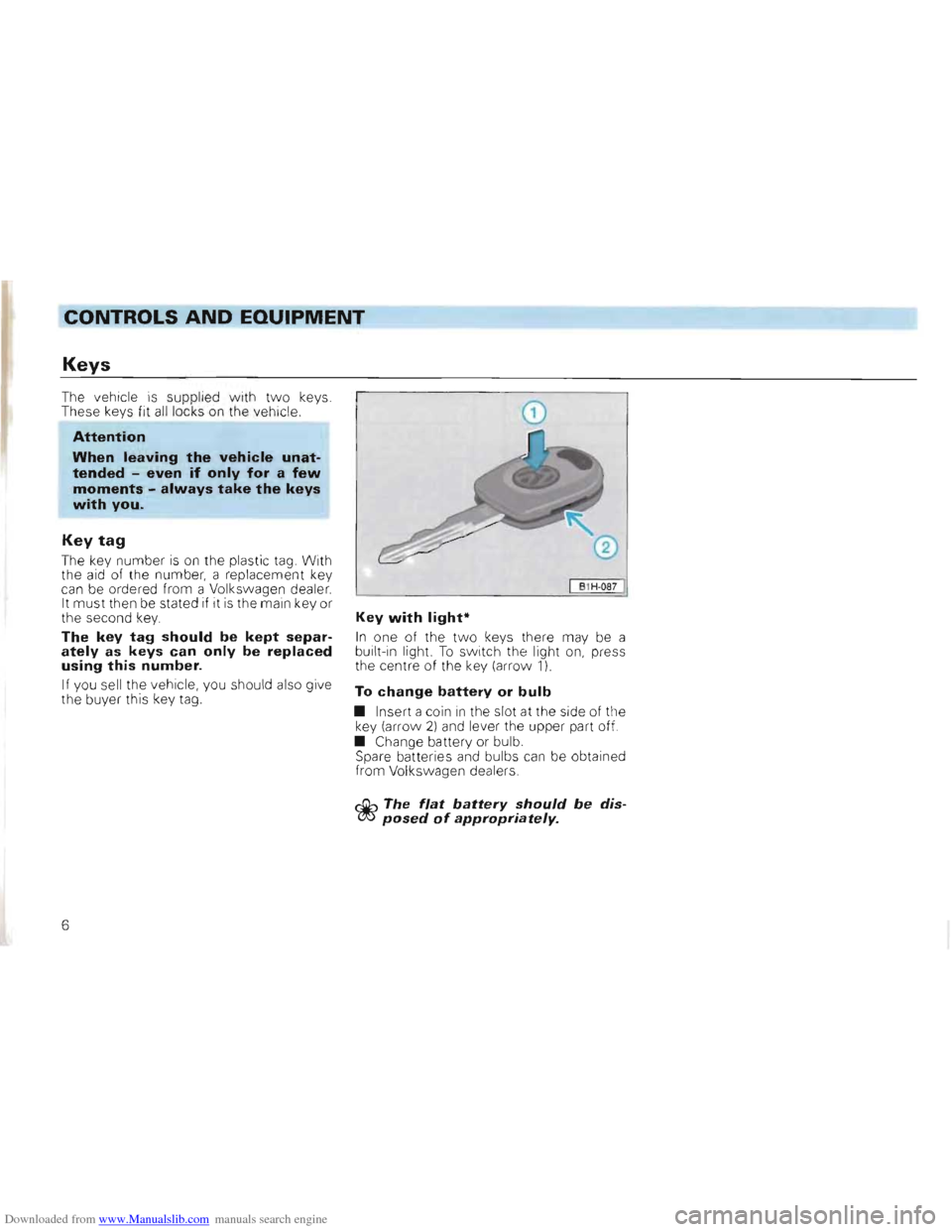
Downloaded from www.Manualslib.com manuals search engine CONTROLS AND EQUIPMENT
Keys
The vehicle is supplied with two keys .
These keys fit all locks on the vehic le .
Attention
When leaving the vehicle unattended -even if only for a few moments -always take the keys with you.
Key tag
The key number is on the plastic tag. With
th e aid of the number , a replacement key can be ordered from a Volkswagen dealer .
It must then be stated if it is the main key or
the second key
The key tag should be kept separ· ately as keys can only be replaced using this number.
If you sell the vehicle , you should also give
the buyer this key tag .
B1H-08 7 I
Key with light*
In one of the two keys there may be a
built-in light. To sw itch the light on, press the cent re of the key (arrow 1)
To change battery or bulb
• Insert a coin in the slot at the side of the
key (arrow 2) and lever the upper part off.
• Change battery or bulb .
Spar e batte
ries and bulbs can be obtained
from Vol kswagen dealers .
&... The flat battery should be dis~posed of appropriately.
6
Page 9 of 156
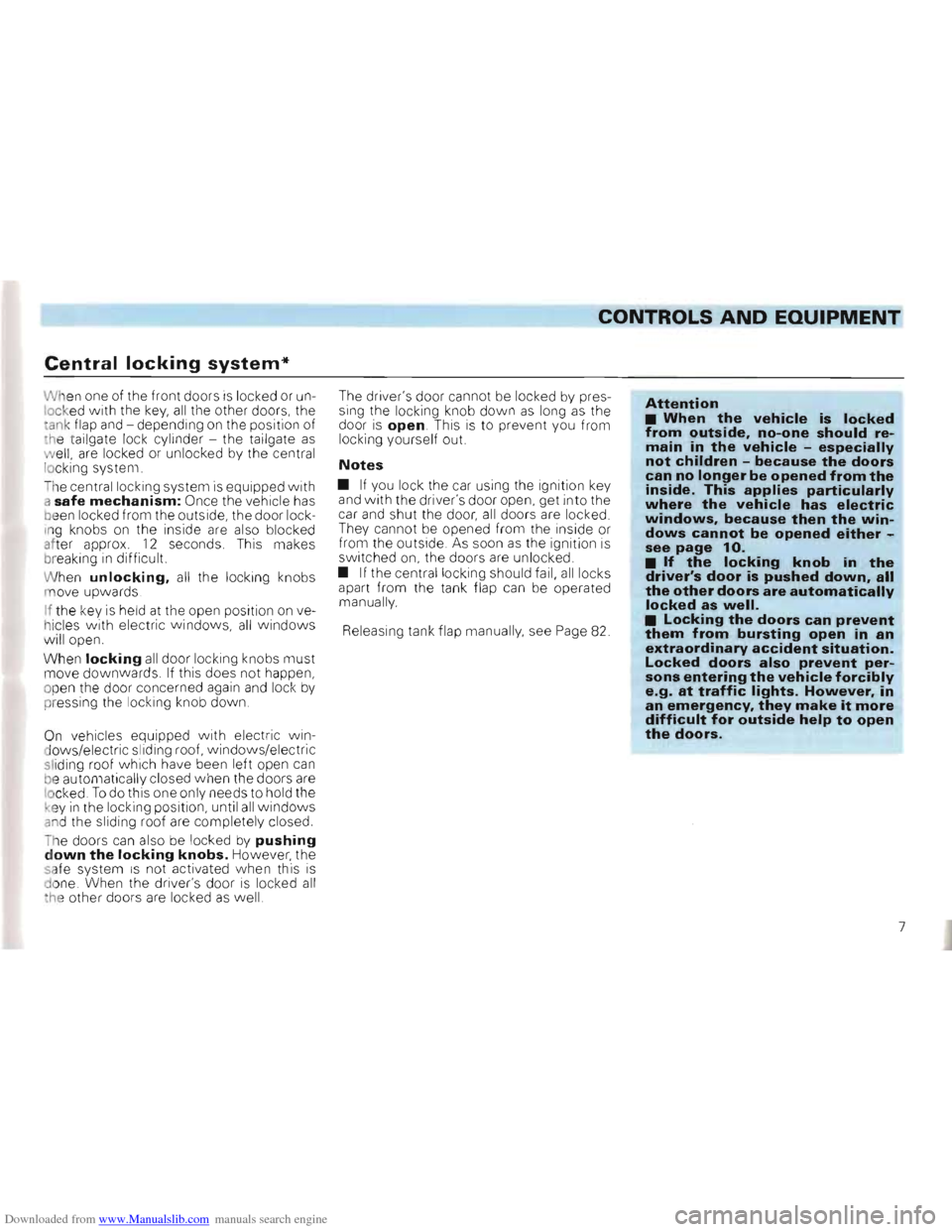
Downloaded from www.Manualslib.com manuals search engine Central locking system*
When one of the front doors is locked or un
lock ed w ith the key, all the other doors, the
tank flap and -depending on the position of
h e tailgate lock cylinder -the tailgate as w el l, are locked or unlocked by the central locking system
T he centra l locking system
is equipped with
a safe mechanism: Once the vehicle has been locked fr om the outside, the door lock Ing knobs on the inside are also blocked
a ft er approx. 12 seconds. This makes
b reaking in d ifficult.
W hen
unlocking, all the locking knobs
m ove upwards .
I f the key is held at the open position on
ve
h icles with electr ic win dows, all windows
wi ll open.
W hen
locking all door locking knobs must
m ove downwards. If this does not happen,
o p
en the door concer ned again and lock by pre ssing the locking knob down .
On ve hicles equipped w ith electric w inows/ele ctri c s liding roof, w indows/ele ctri c
s liding roof w hich hav e been left open can be automatically closed when the doors are
l o cked . T o do this one only need s to hold the
e y
in the lock ing position, until all windows and the sliding roof are completely closed.
The doors can also be locked by pushing down the locking knobs. However, the
s fe system IS not activated when th is is done. When the driver's door is locked all the other doors are locked as well. The
driv er
's door canno t be locked by pres
s ing the locking knob down as long as the
door is open. This is to prevent you from
locking yourself out.
Notes
• If you lock the car using the ignition key and with the driver' s door open, get into the
car and shut the door, all doors are locked.
They cannot be opened from the inside or
from the outs ide. As soon as the ignition is swit ched on, the door s are unlocked .
• If the ce ntral loc king shou ld fail , all locks
apart from the tank flap can be operated
manually.
Releasing tank flap manually, see Page 82.
Attention • When the vehicle is locked from outside, no-one should remain in the vehicle -especially not children -because the doors can no longer be opened from the inside. This applies particularly where the vehicle has electric windows, because then the windows cannot be opened either see page 10. • If the locking knob in the driver's door is pushed down, all the other doors are automatically locked as well. • Locking the doors can prevent them from bursting open in an extraordinary accident situation. Locked doors also prevent persons entering the vehicle forcibly e.g. at traffic lights. However, in an emergency, they make it more difficult for outside help to open the doors.
7
Page 10 of 156
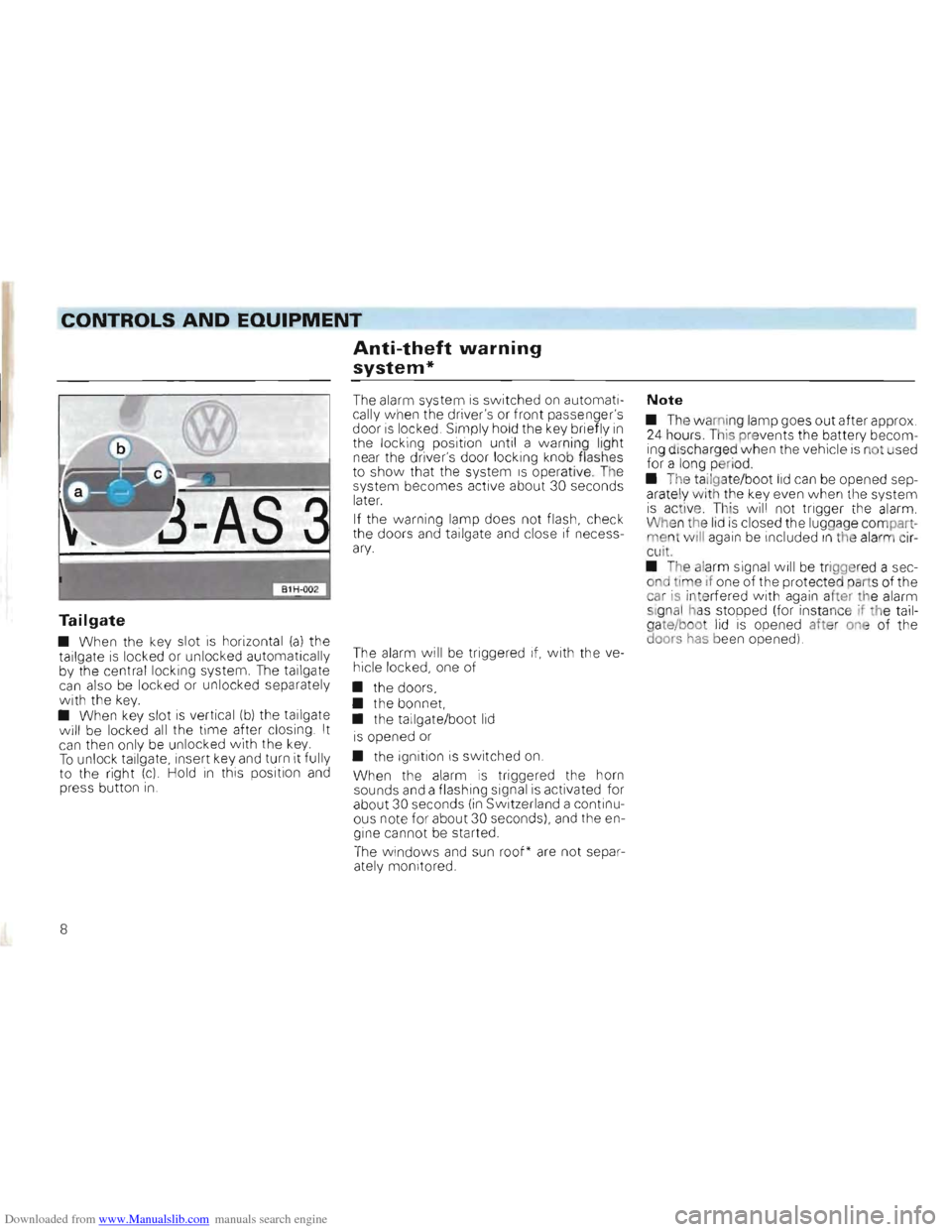
Downloaded from www.Manualslib.com manuals search engine CONTROLS AND EQUIPMENT
Anti-theft warning
system*
Tailgate
• When the key slot is horizont al (a) the
tailgate is locked or unloc ked automatically
by the central locking system. The tallgate can also be locked or unloc ked separately with the key. • When key slot is vertical (b) the tailgate
will be locke d all the time after closing . It can the n only be unlocked with the key. To unlock tailgate , insert key and turn It fully
to the right (c) Hold in this position and press button in .
The alarm system is switched on automatically when the driver's or front passenger's door is locked. Simply hold the key briefly in the locking position until a warni ng light
near the driver's door locking knob flashes
t o show that the system IS operative. The
system becomes active about 30 seconds
lat
er.
If the warning lamp does not flash, check
the doors and tailgate and close if necessary.
The alarm will be triggered if, with the ve
hicle locked, one of
• the doors,
• the bonnet,
• the tailgate/boot
lid
is opened or
• the ignition is switched
on.
When the alarm is triggered the horn
sounds and a flashi ng signal is activated for
about 30 seconds (in Switz erland a continu
ous note for about 30 seconds), and the en
gine cannot be started .
The windows and sun roof* are not separ
ately monitored .
Note
• The wa mi ng lamp goes out after approx . 24 hours. T hiS pre ven ts the battery becom
ing disc harged when the vehicle is not used for a long peri od
• The
tailgate/boo t lid can be opened sep
arate ly wi th the key even w hen the system is active . This wi ll not trigger the alarm .
Whe n the lid is closed the luggag e compartment wili again be included In the alarm circu it.
•
The alarm signal will be triggered a sec
ond time if one of the protecte d part s of the
car
is inte rfered w ith again aher th e alarm
si gnal has stopped (for insta nce if the tailgate/boo t lid is opened after one of the
doors has been opened)
8
Page 11 of 156
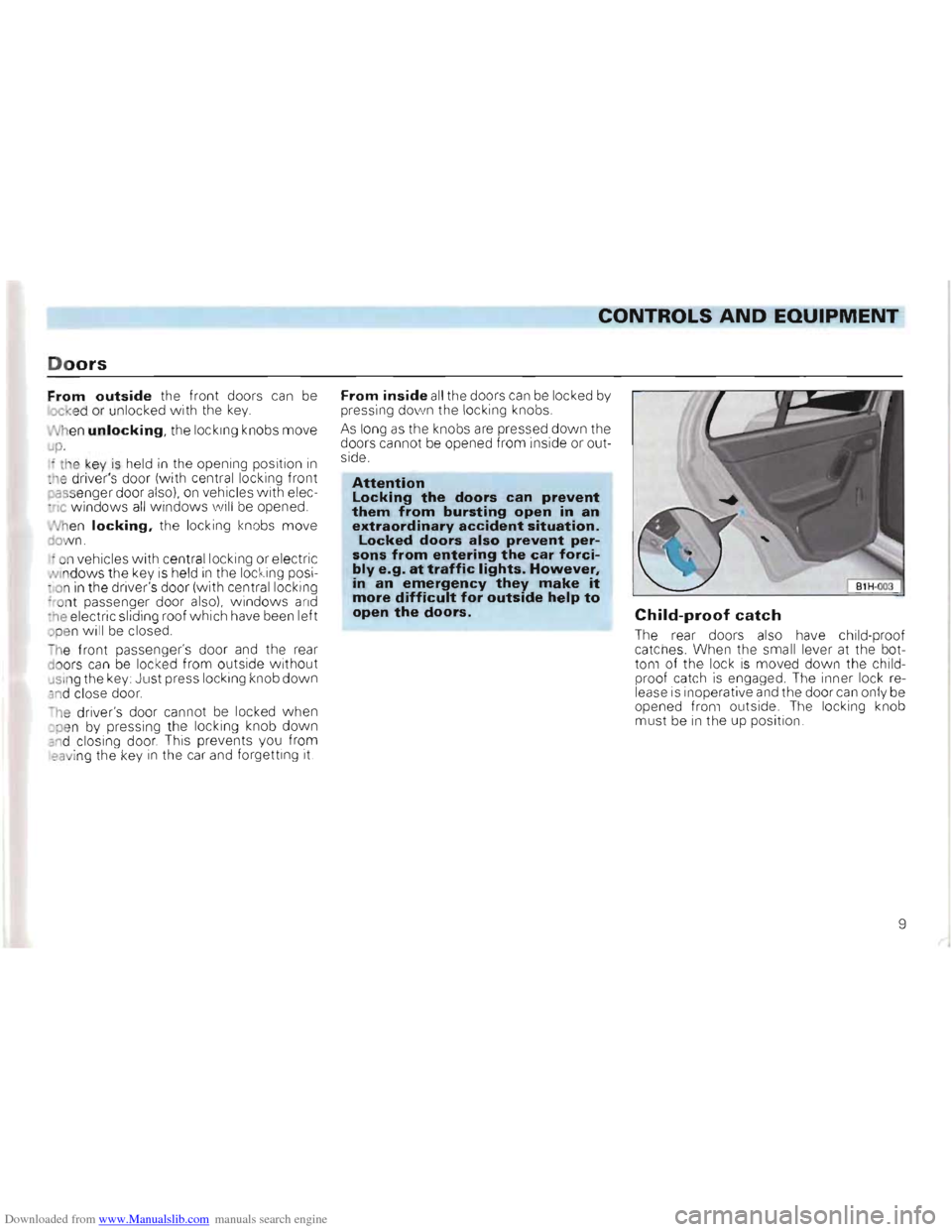
Downloaded from www.Manualslib.com manuals search engine CONTROLS AND EQUIPMENT
Doors
From outside the front doors can be
ocked or unl ocked with the key.
h
en unlocking, the locking knobs move .Jp.
I the key is held in the opening position in .119 d riv er's door (with central locking front passenge r door also), on vehicles with elec
-'le wi ndows all windows will b e opened .
:Jh
en locking, the locking kn o bs move dow n.
-o n vehicles with central locking or electric
Nln dows the key is held in th e loc king posi
- o n in the driver's door (with cen tral lock ing 'ront passe nger door also), windows an d
:ne electric sliding roof which have been left
o pe n w ill be closed.
The fron t passenger's door and the rear
d oors can be locked from outside without Jsing the key J ust press locking knob down and close door.
-he dri ver's door cannot be locked when :Jpe n by pre ssing the locking knob down and closing door . This pre vents you from
eaving the key in the car and forgetting it.
From inside all the door s can be locked by
press ing down the locking knobs.
As long as the knobs are pr esse d down the
doors cannot be opened from inside or outside.
Attention Locking the doors can prevent them from bursting open in an extraordinary accident situation. Locked doors also prevent persons from entering the car forcibly e .g. at traffic lights. However, in an emergency they make it more d ifficult for outside help to open the doors. Child-proof catch
The rear doors also have child-pr oof catc hes . When the small lever at the bot
to m of the lock is moved down the chi ld
proof cat c h i s engaged. The inner lock release is inoperative and the door can only be opened from outside. The locking knob
m ust be in the up po sition .
9
Page 15 of 156
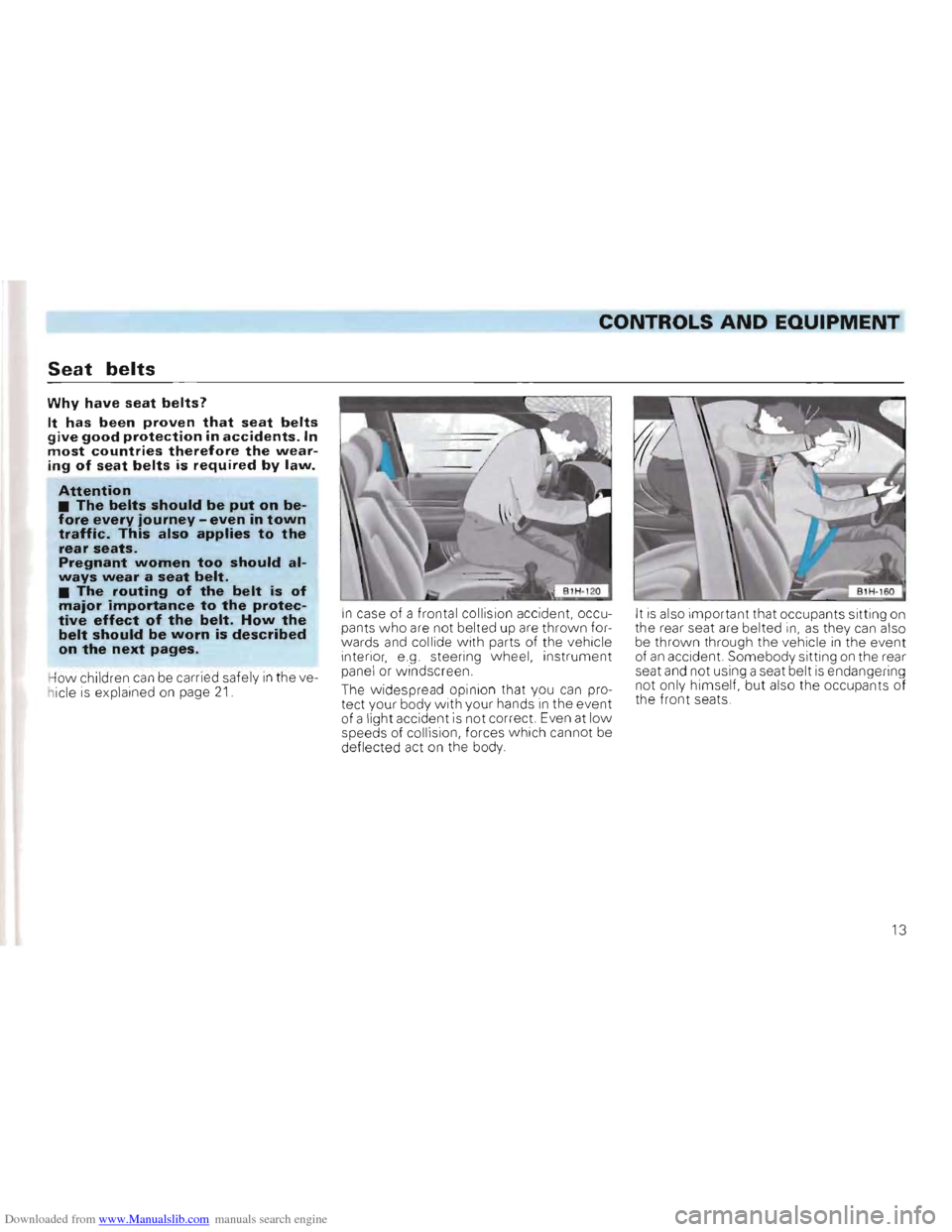
Downloaded from www.Manualslib.com manuals search engine CONTROLS AND EQUIPMENT
Seat belts
Why have seat belts?
It has been proven that seat belts give good protection in accidents. In most countries therefore the wearing of seat belts is required by law.
Attention • The belts should be put on be
fore every journey -even in town
traffic. This also applies to the
rear seats.
Pregnant women too should al
ways wear a seat belt.
• The routing of the belt is of
major importance to the protec
tive effect of the belt. How the
belt should be worn is described
on the next pages.
How children can be carried safely in the ve
h icle is explained on pag e 21 .
In case of a frontal collision accident, occu
pants w ho are not belted up are thrown for
w ards and collide with parts of the vehicle
interior, e.g steering wheel, instrument panel or w ind screen.
The wide spread opinion that you can pro
tect your body with your hands in the event
of a light accident is not corr ect. Even at low speeds of collision, forces which cannot be
deflected act on the body. It
is also
important that occupants sitting on
the rear se at are belted in, as they can also
be th rown throu gh the vehicle in the event
of an accident. Somebody sitting on the rear
seat and not u sing a seat belt is endangering
not only himself , but also the occupants of the front seats.
13
Page 20 of 156
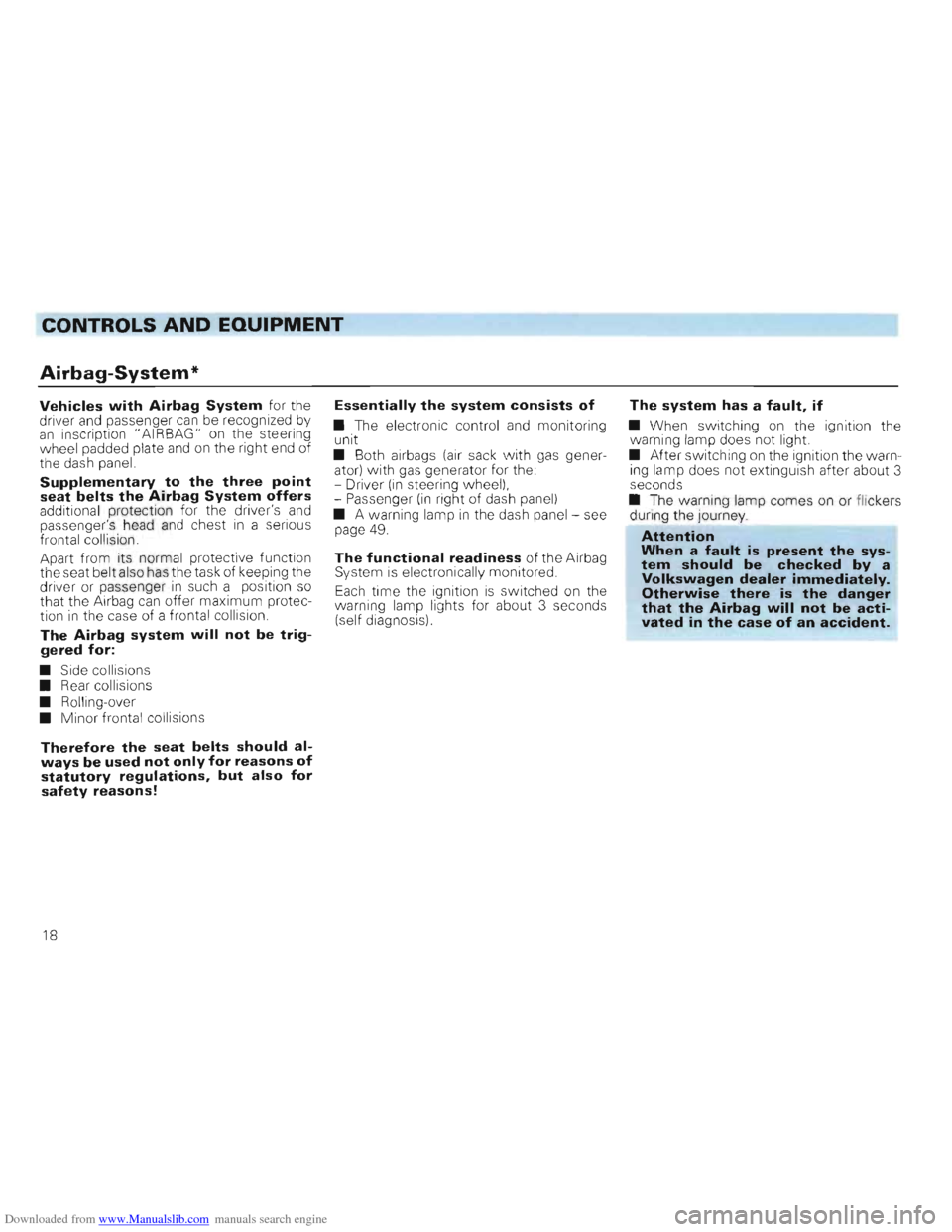
Downloaded from www.Manualslib.com manuals search engine CONTROLS AND EQUIPMENT
Airbag-System*
Vehicles with Airbag System for the driver and passenger can be recognized by an inscription "AI RBAG" on the steering wheel padded plate and on the right end of the dash panel.
Supplementary to the three point seat belts the Airbag System offers additional protection for the driver's and passenger's head and chest In a serious
frontal collision.
Apart
from its normal protective function the seat belt also has the task of keeping the
driver or passenger in such a position so
that the Airbag can offer maximum protec
tion in the case of a frontal collision.
The Airbag system will not be triggered for:
• Side collisions
• Rear collisions
•
Rol l i ng-over
• Minor frontal collisions
Therefore the seat belts should always be used not only for reasons of statutory regulations, but also for safety reasons!
Essentially the system consists of
• The electronic control and monitoring
unit
• Both airbags (air sack
with gas gener
ator) with gas generator for the:
- Driver (in steering wheel),
- Passenger (in right of dash panel)
• A
warning lamp in the dash panel -see
page 49.
The functional readiness of the Airbag
System is electronically monitored.
Each
time the ignition is switched on the
warning lamp lights for about 3 seconds
(self diagnosis).
The system has a fault, if
• When switching on the ignition the warn ing lam p does not light.
•
After swi tching on the ignition the warn
ing la m p does not extinguish after about 3
second s
• The warning lamp
comes on or flickers
du rin g the Journey.
Attention
When a fault is present the sys
tem should be checked by a
Volkswagen dealer immediately.
Otherwise there is the danger
that the Airbag will not be acti
vated in the case of an accident.
18